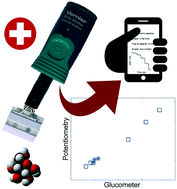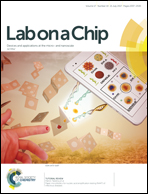A novel wireless paper-based potentiometric platform for monitoring glucose in blood†
Abstract
A novel low-cost, compact and sensitive paper-based platform for the accurate monitoring of glucose in biological fluids is presented. Paper-based working and reference electrodes are combined to build a whole potentiometric cell, which also fits a sampling module for simple and fast determination of glucose in a single drop of blood. The working electrode is built using a platinized filter paper coated with a Nafion membrane that entraps the enzyme glucose oxidase; the reference electrode is made by casting a polyvinylbutyral-based membrane onto a conductive paper. The system works by detecting the hydrogen peroxide generated as a result of the enzymatic reaction. Selectivity is achieved due to the permselective behaviour of Nafion, while a significant enhancement of the sensitivity is reached by exploiting the Donnan-coupled formal potential. Under optimum conditions, a sensitivity of −95.9 ± 4.8 mV per decade in the 0.3–3 mM range is obtained. Validation of the measurements has been performed against standard methods in human serum and blood. Final integration with a wireless reader allows for truly in situ measurements with a less than 2 minute procedure including a two-point calibration, washing and measurement. This low-cost analytical device opens up new prospects for rapid diagnostic results in non-laboratory settings.

- This article is part of the themed collection: Lab on a Chip Recent Open Access Articles


 Please wait while we load your content...
Please wait while we load your content...